Site Study: Japanese knotweed control on the Sheriff Burn, a tributary of the River Don, Aberdeenshire
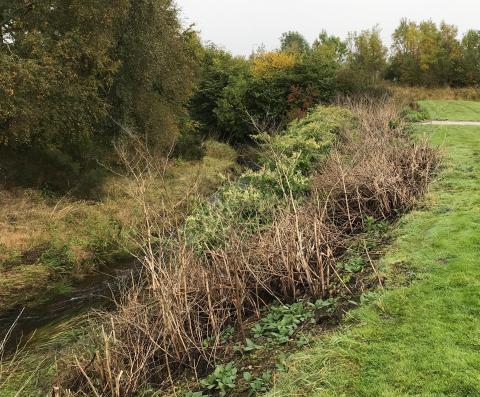
Summary
The Sheriff Burn is a small tributary of the River Don running through the village of Kintore in Aberdeenshire.
Since 2011 Japanese knotweed has been controlled on the River Don between the villages of Strathdon and Kintore by the River Don Trust and Don District Salmon Fishery Board (DSFB), with support from volunteers. During this programme Don DSFB staff identified a small infestation of Japanese knotweed on the Sheriff Burn which has the potential to spread downstream into the River Don.
From 2018 access was granted from the landowner, Precision Oil Tools Ltd, allowing chemical control to take place. This was coordinated by the River Dee Trust as part of the Scottish Invasive Species Initiative. Annual control has been required since 2018 due to the initial density and well-established nature of the Japanese knotweed infestation. By 2021 the stand had been reduced in scale and extent and eradication is now a realistic proposition at the site. Ongoing treatment of recurring plants is required to achieve this outcome.
1. Site description
This small, isolated section of Japanese knotweed present on the right bank of the Sheriff Burn has the potential to spread downstream and to the main River Don if not controlled. The site is located next to a car park of a business park near the A96, which is immediately adjacent to the burn.
The small site, around 50m in length (grid reference NJ 7906 1412), is owned by Precision Oil Tools Ltd. The site location is shown in Map 1.
Within the Scottish Invasive Species Initiative partnership the River Don catchment is covered by the River Dee Trust.
Map 1: Location of Japanese knotweed on the Sheriff Burn - a tributary of the River Don in Aberdeenshire
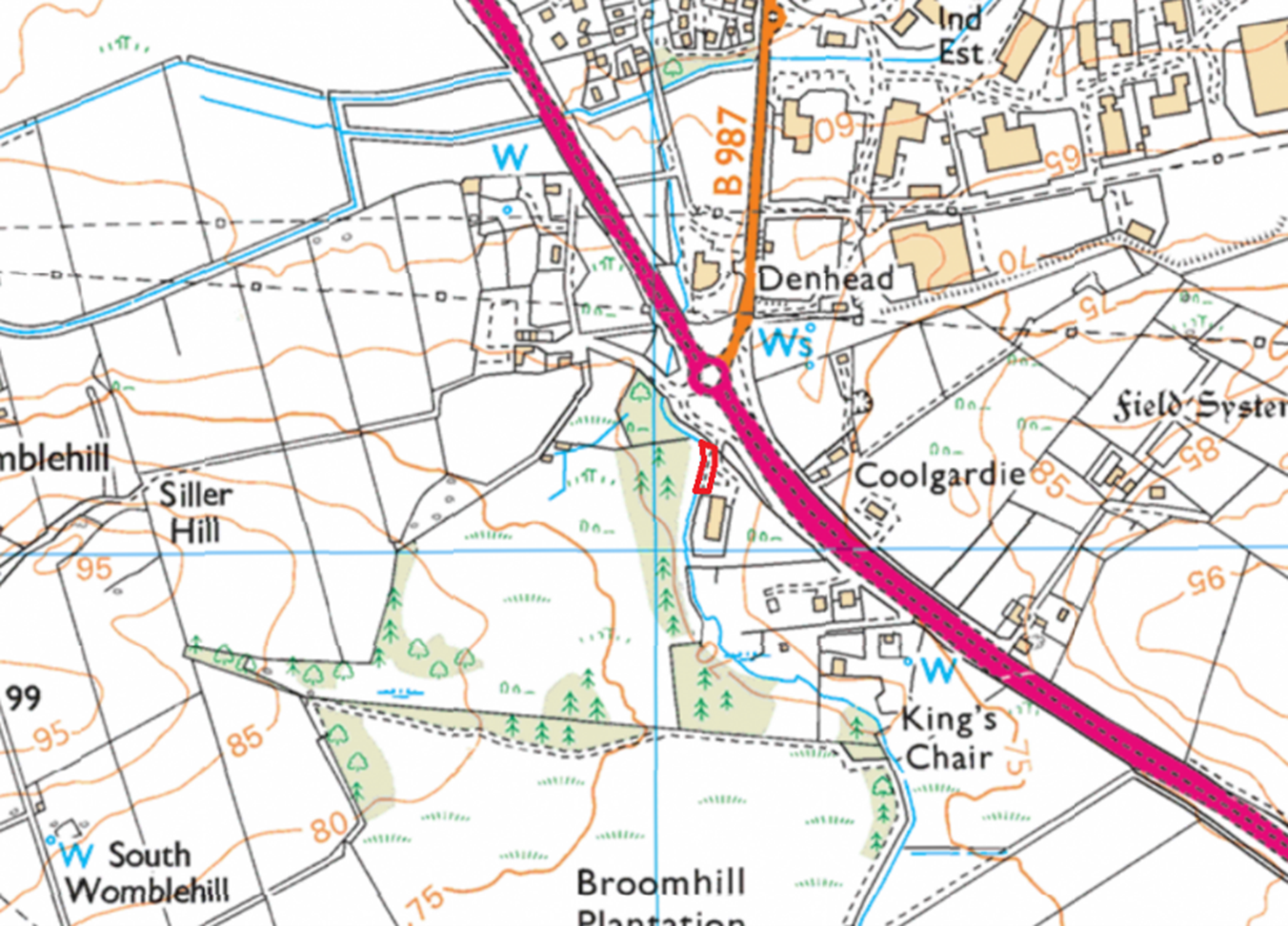
2. Background
During 2011 the River Don Trust, assisted by volunteers and the Don DSFB, undertook a programme of invasive plant control supported by the Water Environment Fund – a fund managed by the Scottish Environment Protection Agency.
This programme supported the survey and mapping of invasive non-native plant species and created a pool of trained volunteers who were able to support local plant control. Although local control was delivered successfully until 2013, overall progress across the catchment was slow due to the extensive and dense invasive plant stands identified.
This previous programme identified presence of Japanese knotweed on the Sheriff Burn site and, following discussion with the owner, became an active control site in 2018 as part of the Scottish Invasive Species Initiative.
3. Management works
The Japanese knotweed stand on the Sheriff Burn has been treated by the River Dee Trust since 2018 as part of the Scottish Invasive Species Initiative.
The stand was treated annually using glyphosate (Round-up ProVantage) applied as a foliar spray (spraying directly onto the leaves of the plant) by backpack sprayer. Spraying took place at the time of flowering, in late September to early November.
A summary of the control treatments is presented in Table 1 (below).
Table 1 – Summary of Japanese knotweed control on the Sheriff Burn, River Don
| Year | Invasive Species | Control work completed by | Control work - date and method |
| 2018 | Japanese knotweed | Project partner staff | 28/09/18 – Foliar spray |
| 2019 | Japanese knotweed | Project partner staff | 24/09/19 – Foliar spray |
| 2020 | Japanese knotweed | Project partner staff | 21/09/20 – Foliar spray |
| 2021 | Japanese knotweed | Project partner staff and volunteers | 08/11/21 – Foliar spray |
4. Results
4.1 Invasive species abundance
Due to the small scale of the Sheriff Burn site Japanese knotweed abundance was recorded at a single monitoring point (grid reference NJ 7906 1412).
The abundance of Japanese knotweed was measured using the DAFOR* scale and is shown in Table 2.
The extent and abundance of Japanese knotweed on the Sheriff Burn remained unchanged over control years 2018-2020, with the plant recorded as ’dominant’. However, both the extent and abundance of the plant was reduced in 2021 when it was recorded as ‘frequent’. This meant that annual control consisted of spraying a declining number of emerging stems with very few plants strong enough to support the growth of a flowering head.
This recorded change in abundance was also observed by changes on the ground (see Figures 1a and 1b showing within year progress (2020) and Figures 2a and 2b showing within year progress (2021)).
Table 2 - Annual Japanese knotweed abundance from surveys (2018 – 2021) on Sheriff Burn, River Don
| Site name | Japanese knotweed abundance by year (DAFOR* scale) | |||
| 2018 | 2019 | 2020 | 2021 | |
| Sheriff Burn | D | D | D | F |
* - DAFOR Scale of abundance – D = Dominant (50 – 100% cover), A = Abundant (30 – 50% cover), F = Frequent (15 – 30% cover), O = Occasional (5 – 15 % cover), R = Rare (<5% cover)
| Figure 1a and 1b – Sheriff Burn (2020) - Japanese knotweed before and after control | |
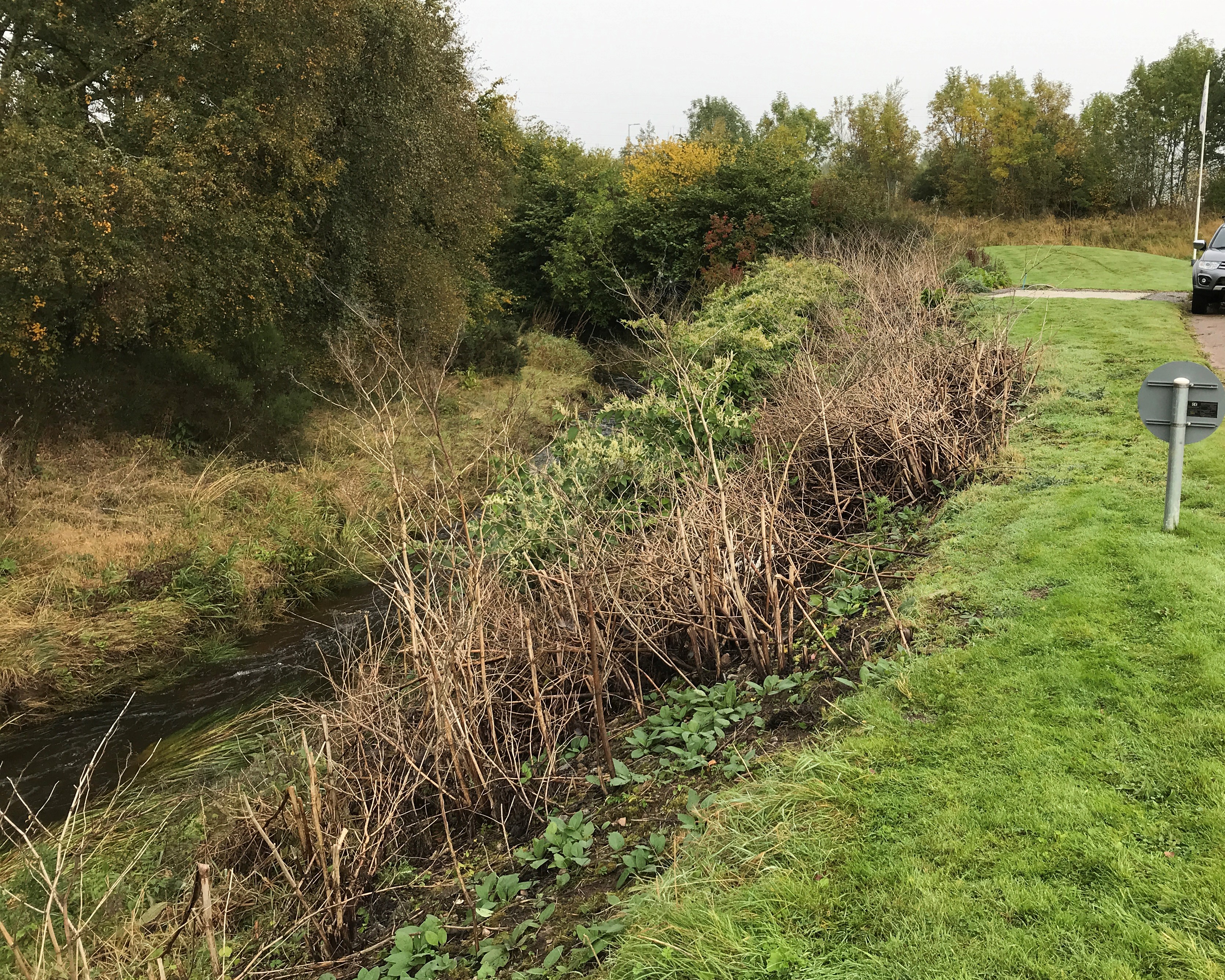 |
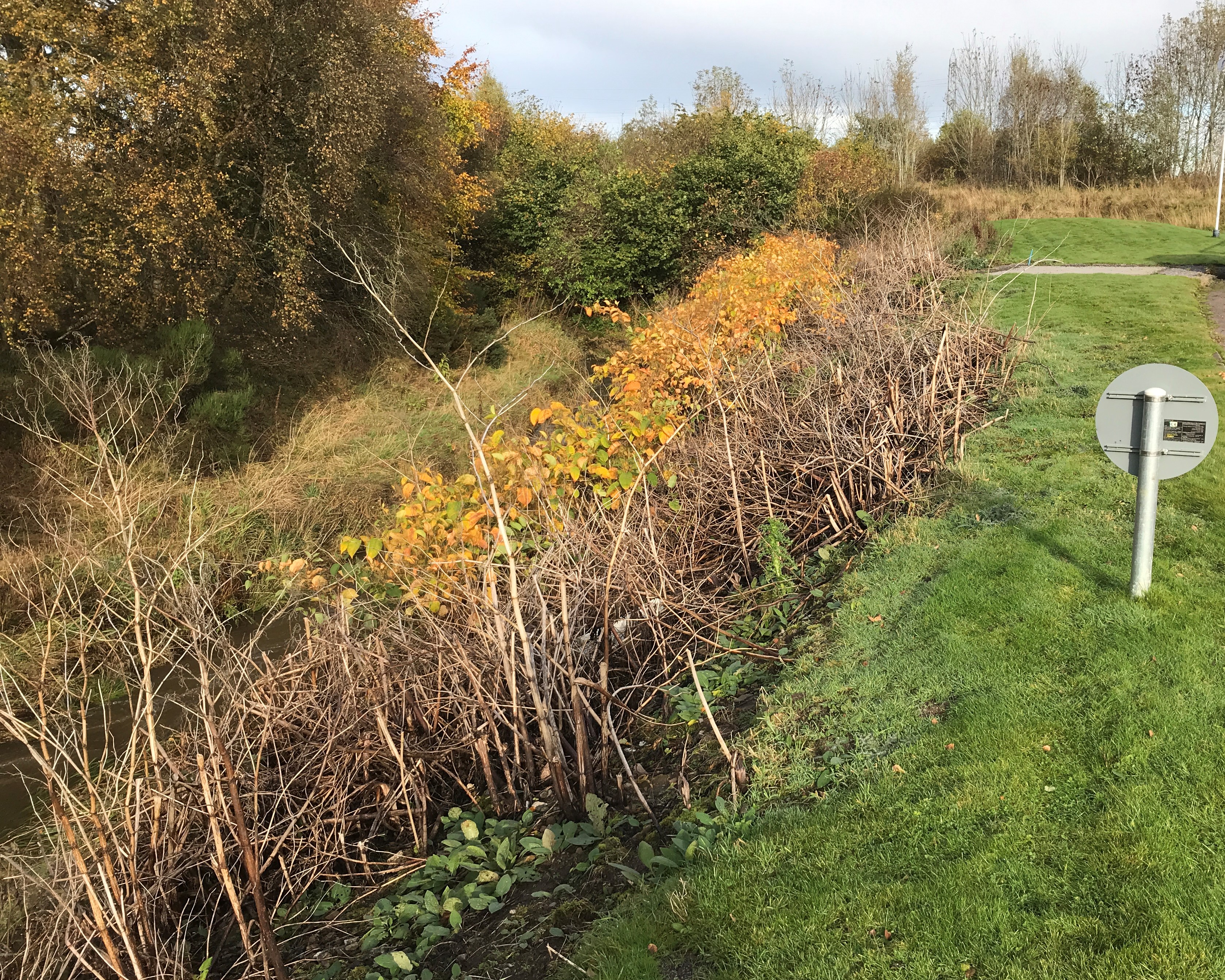 |
|
Figure 2a and 2b – Sheriff Burn (2021) - Japanese knotweed before and after control |
|
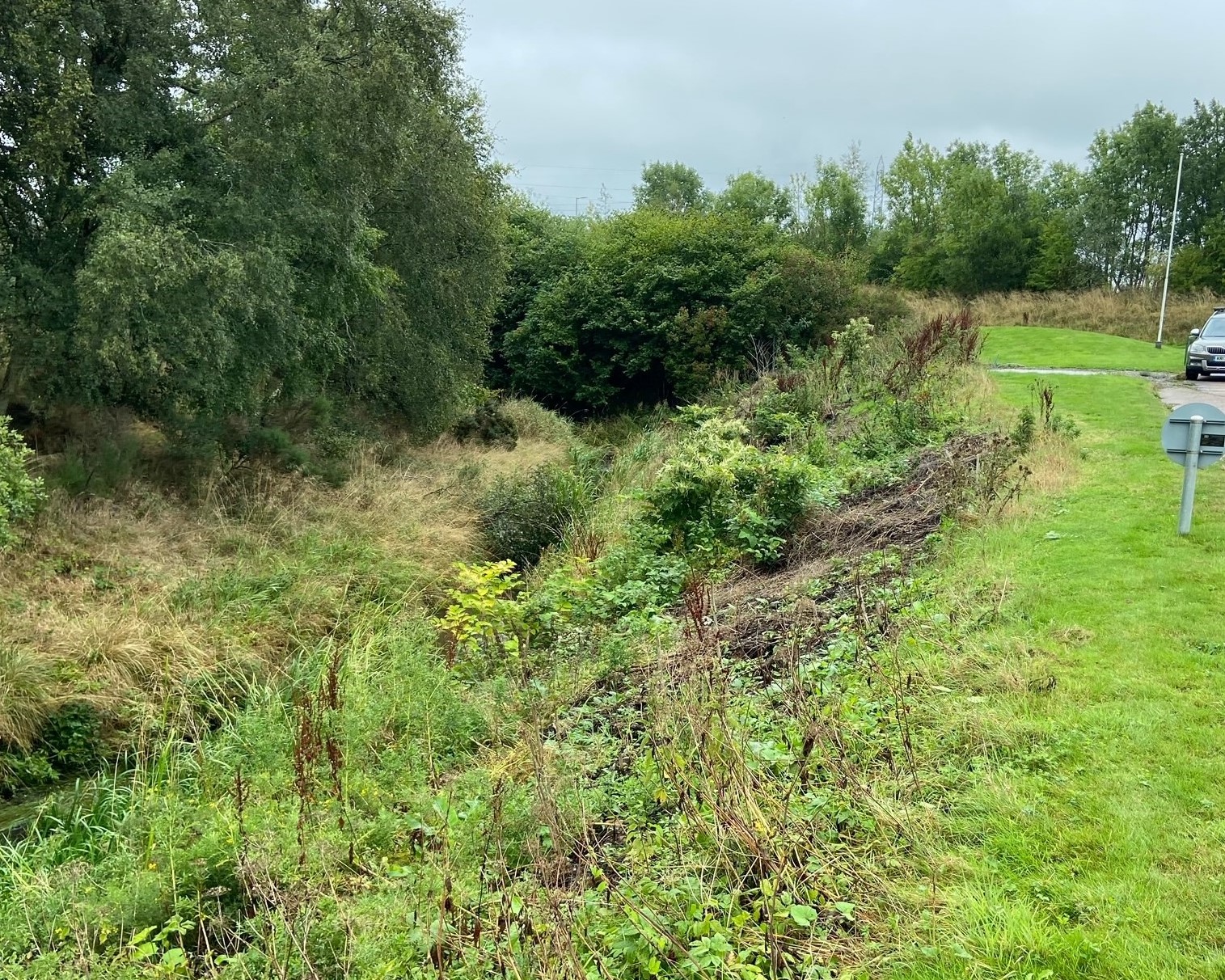 |
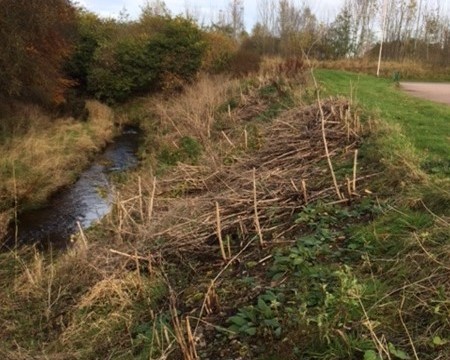 |
4.2 Chemical usage
Chemical use was recorded on an annual basis at the site. Glyphosate was applied as a foliar spray at a concentration of 20ml per litre.
Table 3 (below) shows the total volume of glyphosate used in each control year.
Table 3 – Volume of glyphosate used to control Japanese knotweed (2018 – 2021) on Sheriff Burn, River Don.
| Site name | Glyphosate used (litres) by year | |||
| 2018 | 2019 | 2020 | 2021 | |
| Sheriff Burn | 0.1 | 0.1 | 0.6 | 0.2 |
4.3 People effort
Control work was undertaken by staff from The River Dee Trust in all years and with volunteer support in 2021.
Table 4 (below) shows effort in terms of hours of control work per year at the site. The consistently low time allocations reflect the small and localised nature of the infestation.
Table 4 – People hours used to control Japanese knotweed (2018 – 2021) on Sheriff Burn, River Don
| Site name | Hours of control work by year | |||
| 2018 | 2019 | 2020 | 2021 | |
| Sheriff Burn | 1 | 2 | 1 | 1 |
5. Conclusions and Progress Made
Japanese knotweed control on the Sheriff Burn has now taken place consistently for four years (2018 – 2021) with control also scheduled for 2022. Initially, in the first two seasons, treatment targeted peripheral and edge plants and worked from the outside of the patch to the inside controlling the perimeter without being able to treat the plants in the centre of the stand. This sequential approach delayed the anticipated reduction in Japanese knotweed abundance at the site until 2021.
By 2021 the extent and abundance of Japanese knotweed at the site had reduced. Currently the stand consists of several small clumps of annual growth all of which are easily accessible for control. Work due to be completed in 2022 is anticipated to require less effort than previous years and to move closer towards eradication of Japanese knotweed from the site.
Monitoring and necessary control work beyond 2022 will be essential to ensure eradication is achieved and to both prevent the regrowth of Japanese knotweed on the Sheriff Burn and ensure that the site does act as a source of material for infestation downstream and to the River Don.
6. Next Steps
Monitoring and control of Japanese knotweed on the Sheriff Burn will continue in 2022 under the Scottish Invasive Species Initiative and via the River Dee Trust with the Don DSFB. Treatment of remaining and emerging plants will continue in order to work towards the eradication of Japanese knotweed from the site.
The Don DSFB is committed to controlling Japanese knotweed across the River Don catchment and in particular in the Strathdon to Alford reach, having committed funds to bridge the time gap between funded control programmes. It is likely that this approach would continue in the future alongside direct engagement with landowners to support local delivery.
The level of control work required in 2022 is anticipated to be less than in previous years. Eradication of Japanese knotweed from the current Sheriff Burn site is achievable and will also prevent infestation of downstream locations on the burn and the River Don from this source.
Further information
Contact: [email protected]
Download this Case Study as a PDF
